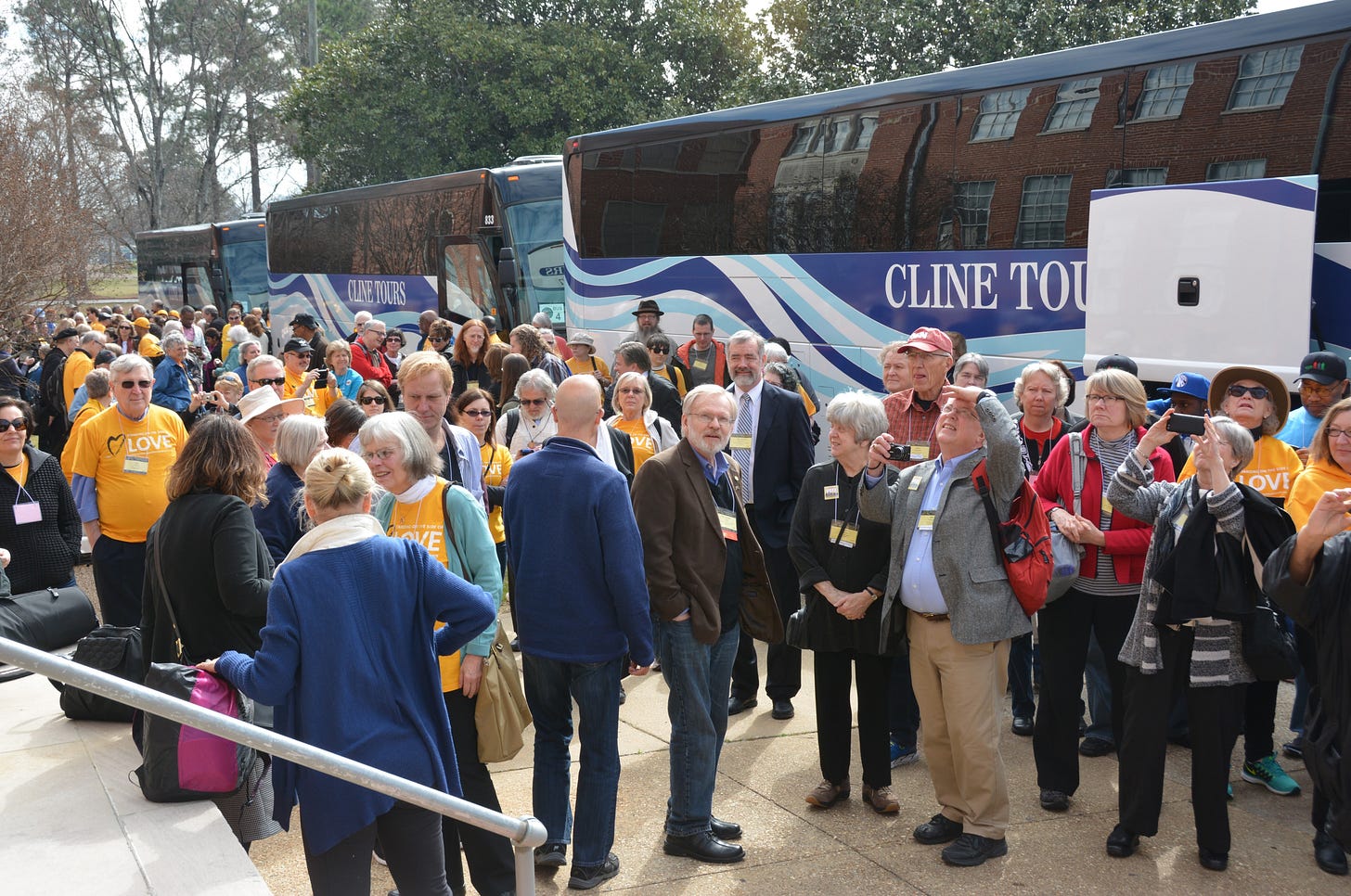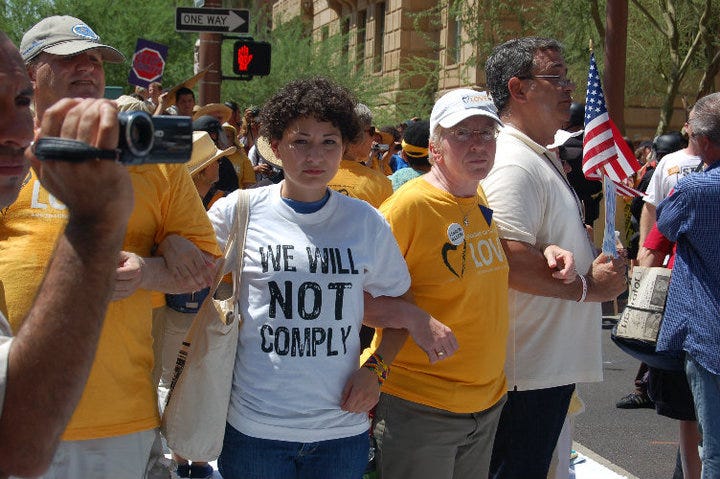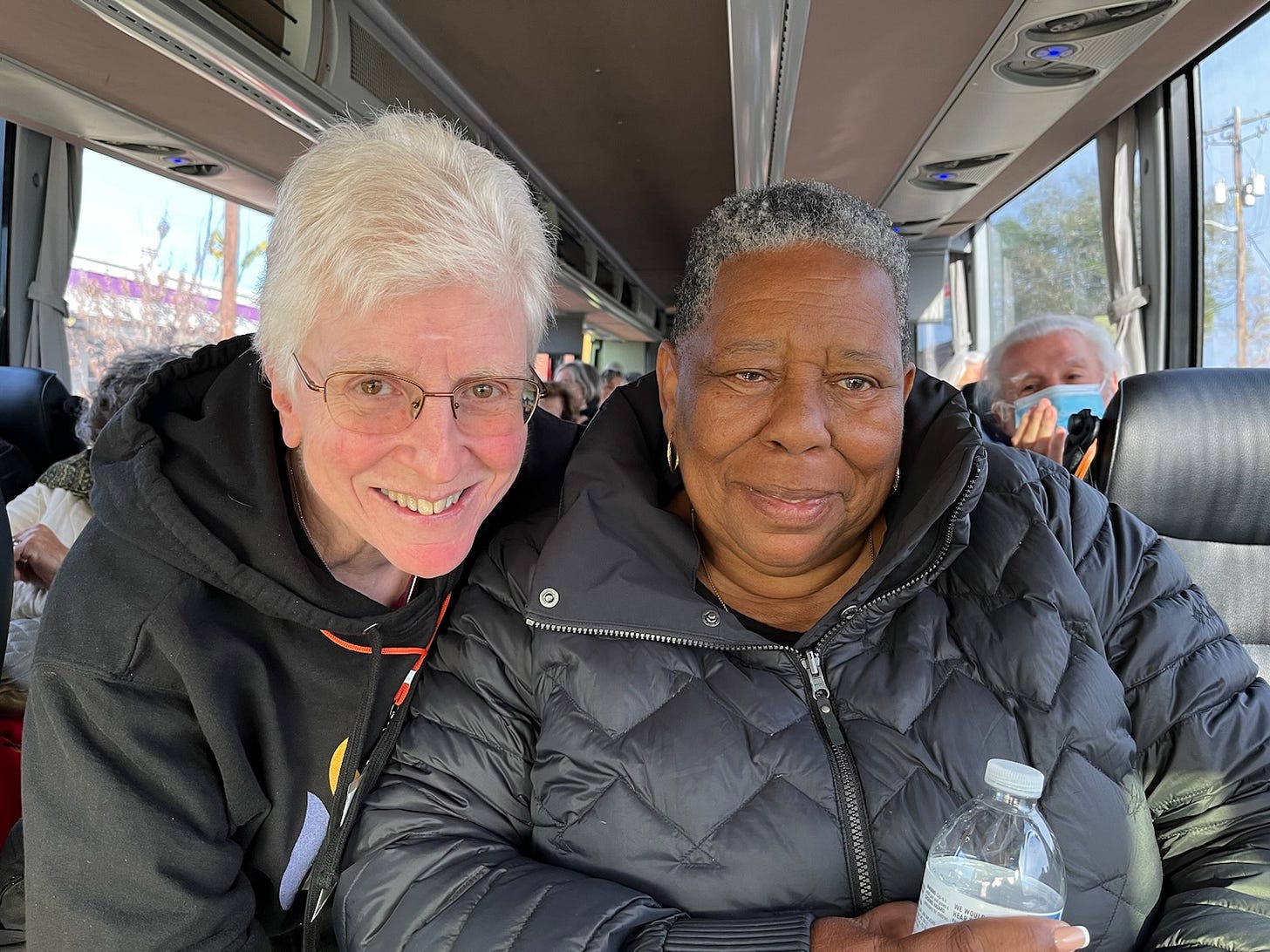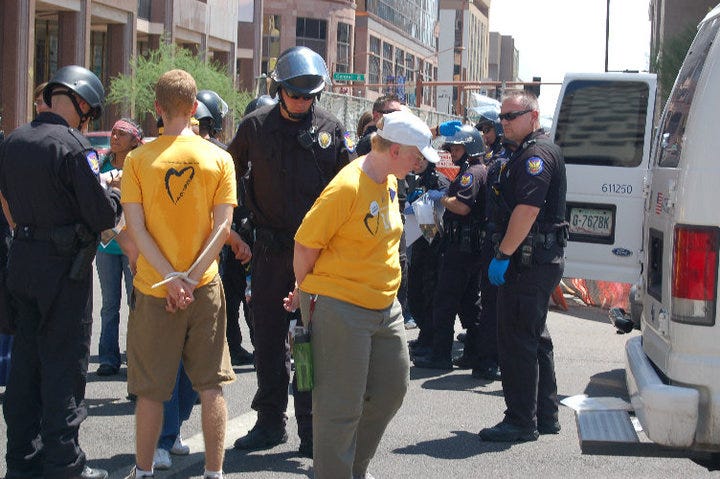The Decision to Resist
What are you willing to do to resist? How far will you go for a cause you believe in?
Fifteen years ago this summer I chose to put myself in the position to be arrested for an act of civil disobedience. I hadn’t done it before then and haven’t done it since. Because of the political climate we’re living in, I’ve been thinking a lot about it lately. Would I do it again? For what cause? At what point will things be bad enough that I might choose to risk my freedom by refusing to cooperate?
A number of friends have asked for help in discerning what to do in response to the assault on our democracy and the even more blatant attacks on immigrants, transgender people, and DEI initiatives we’ve seen over the past five weeks. As I’ve told them, there are numerous ways to respond, and one response doesn’t preclude another.
I encourage everyone to start by finding your community—at least five people who will support, inform, educate, and encourage you in whatever you decide to do. That could be your local Democratic Committee, a women’s political group such as Liberal Women of Chesterfield County or Red, Wine, and Blue, a liberal faith community such as a nearby Unitarian Universalist congregation, or a group of like-minded family or friends. The important thing is to have support, so you don’t feel alone. Isolation feeds autocracy, fascism, and hopelessness.
After that, I suggest that, especially if you’ve never been active before, you start small. Plan to make phone calls to your legislators at least weekly about issues that concern you. Phone calls, even to Democratic lawmakers, matter. They’re an important way to make your voice be heard and support things you care about. And lawmakers do listen to constituents. To get started, download the 5 Calls app. It offers a list of your congresspeople and background information and call scripts for pressing issues.
What you do after tha and t, joining a local protest, rally, or vigil, writing letters to the editor, participating in boycotts (such as the Feb 28th Economic Boycott or Black Leaders’ 40 Day Fast from Target), donating to advocacy groups, or myriad other ways of voicing your opposition to what’s happening can be based on your own concerns and the level of risk you want to assume.
We all need to begin thinking about our willingness to participate in moderate and higher risk protest activities, such as civil disobedience, sit-ins and occupations, strikes and walkouts, and defying government protest bans. It’s better to consider what you’re willing to do to stand against immoral and unethical policies and laws now, before you are called to do so. How far will you go?
I’d Like Your Input
I’m considering developing a four to six session asynchronous online course designed to help you identify a cause or causes you’re most passionate about, assess the risks for you of various forms of protest, and develop a personal action plan for meaningful engagement. Let me know if this is something you might be interested in. It would be available free to paid subscribers and at a modest sliding scale fee for anyone else.
The following excerpt from my memoir: Resistance: A Memoir of Civil Disobedience in Maricopa County (which I plan to re-release soon), focuses on my decision to be arrested in Phoenix in 2010 to express my opposition to SB 1070, the “Papers Please” law. I hope it will help you think about when and under what circumstances you might choose to resist.
Time to Do Something Real
July 29, 2010, 10:22 a.m. Even in the early morning hours, the Arizona sun scorched us as we marched from Trinity Episcopal Cathedral to Cesar Chavez Plaza in Phoenix. I now stand with hundreds of other protestors, baking in that sun, at the intersection of Washington Street and First Avenue in downtown Phoenix. I’m sure it must be at least 120 degrees out here. Sweat trickles down my chest and back and pools at the waistband of my pants. Fortunately, I stopped at a sporting goods store last night and bought a lightweight white golf cap. ClimaCool, it’s called. I can’t say it’s keeping me cool but at least sweat isn’t dripping down my face as well. In addition to my protective hat, I’m wearing a bright, goldenrod-colored T-shirt with the logo and motto of Standing on the Side of Love (SSL) campaign, a public witness program of my faith community, the Unitarian Universalist Association. My arms are linked firmly at the elbow with two other protestors, so if the hat doesn’t do its job, there is no way I can wipe the sweat from my face.
Today is the day Arizona enacts its latest anti-immigration legislation, SB 1070, commonly referred to as the “Papers, Please” law. This law requires everyone, American citizen or not, to carry identification papers or risk being arrested as an illegal alien. As a middle-class, White woman of French, Irish, and German descent, I know police will not stop me and ask me for my papers. They target only people of darker skin, people who do not speak English as a primary language, people who, according to the police, “look” illegal. Systematically targeting and arresting people because they fit a profile of an illegal immigrant violates the first of the seven Principles of Unitarian Universalism, which affirms “the inherent worthy and dignity of every person.” This egregious violation of human rights prompted me to decide, along with scores of other Unitarian Universalists, to engage in nonviolent civil disobedience and put myself in the position of being arrested. I also chose, as is my right as an American citizen, not to carry my identification with me.
Organizers of the protest picked this particular intersection to intentionally cut off access to the offices of Joe Arpaio, the Maricopa County Sheriff, who is notorious for his inhumane treatment of suspected illegal immigrants.
As I watch the Phoenix police decked out in riot gear approach, I feel a strange mixture of clarity, resolve, and terror. My chest tightens and I wonder if all my sweating is the result of the relentless Phoenix sun. This is the first time in my thirty-five years as an activist that I’m prepared to be arrested for a deliberate act of civil disobedience.
The man holding my arm to my left is bigger than me, taller and stouter. His face appears calm even though his eyebrows are raised as if he is surprised by the intensity of what’s happening around him. He’s Latino, as is the smaller woman, closer to my size, on my right arm. Angie is her name. I introduced myself a moment ago but didn’t have a chance to ask the man’s name before we linked arms. His stern expression tells me it’s better not to interrupt him now. Angie is wearing a white T-shirt emblazoned with the words “We Will NOT Comply.” She wears a wide Mexican bracelet on her wrist, beaded with the colors of the earth and sky—blue, green, orange, and yellow. She watches the police with the eyes of someone who’s previously fallen prey to their abuses. I wonder about her story.
My story is that in 2007, I went on a civil rights bus tour of the deep South led by Gordon Gibson, a Unitarian Universalist minister who’d spent many years working in Mississippi and who had himself been arrested in Selma, Alabama, in the 1960s, protesting for voting rights for Black people. During that tour I met people who had risked everything for the right to vote. Our group talked with people like Joanne Bland from Selma. As a young child during the early 1960s, Joanne peered longingly into the drug store window in downtown Selma, craving an ice cream cone like the ones being enjoyed inside by little White girls her age. She begged her grandmother to let her go in and get one. “No,” her grandmother replied sharply, as she pulled her away from the window, “When you get your freedom, then you can go in and get ice cream.” Joanne joined the civil rights movement that day, and by the time she was eleven, had been arrested thirteen times.
We met with Hollis Watkins, who, in addition to being arrested too many times to count, sang and wrote verses for old spirituals to give courage to those priming themselves for jail. I could imagine Hollis as a strapping young teenager with a voice like velvet, emboldening the other protestors as they nervously gathered outside a church in Jackson, Mississippi, more than forty years ago. He sang,
Ain’t gonna let nobody
Turn me ’round,
Turn me ’round,
Turn me ’round,
Ain’t gonna let nobody
Turn me ’round,
Keep on a walkin’,
Keep on a talkin’,
Marchin’ up to Freedom Land.
Through their stories and the stories of many other veterans of the civil rights movement, I came to understand, in entirely new ways, the incredible sacrifices that people made for what they believed in.
What had I given up for my beliefs? I’d marched for women’s rights, for gay and lesbian rights, and against nuclear power. I’d protested and leafleted, organized, and made endless phone calls. But what had I really risked? I hadn’t chained myself to the White House gate, scaled the fences at the School of the Americas, or thrown blood on the steps of the Pentagon. I hadn’t climbed old-growth trees or blocked the entrance to military facilities. I hadn’t done anything that would constitute real risk. Truth be told, I viewed the people who did those things as extremists, the ones who had nothing to lose. I questioned their tactics, the impact that their actions had. How could one person or a small group of people acting outside the law really change anything? But the people I met and the stories I heard about the civil rights movement caused me to question everything I had thought up to this point in my life.
When Fannie Lou Hamer was forty-five years old, she tried to register to vote. Like many African Americans in the 1950 and 60s, she was denied her legal right to register. The very next day, the owner of the plantation where she had lived as a sharecropper for seventeen years threw her out of her home—just for trying to register. After that, she never stopped fighting for her rights.
In the 1960s, two Unitarian Universalists paid the ultimate price at the height of the civil rights movement. James Reeb, a White Unitarian Universalist minister, and two colleagues, the Rev. Clark Olsen, and the Rev. Orloff Miller, were taking a shortcut back to Brown Chapel in Selma when three men attacked them with baseball bats. Reeb never regained consciousness and died two days after the attacks.
Viola Liuzzo, a White mother of four, a Unitarian Universalist from Detroit, died on the side of a lonely highway as a car pulled up beside her. One of the occupants of that car raised a gun to the open window and shot her in the head. People risked their livelihood, their safety, their freedom, and their lives to have a stake in this democracy.
I was so moved by the courage, the determination, the ferocity of the stories of the civil rights movement that I helped organize two subsequent bus tours, renamed them pilgrimages, and challenged the pilgrims to evaluate their own spiritual journeys as activists in the context of the movement. The Living Legacy Pilgrimage is now a regular event that attracts people from around the country who want to learn about this extraordinary time in our history.

But was that enough? Even with the great amount of time and investment it takes to plan a pilgrimage, it is still what I call “one-off” activism. It’s voyeuristic, tidy, sanitary activism. I often hear from participants how transformational the trip was for them and I have to ask, “What has it transformed you to do?” Because without action, transformation is an empty bus going nowhere.
For all my words, though, when a call went out from Susan Frederick Gray, a Unitarian Universalist minister based in Phoenix, to UUs across the country to come to Phoenix on May 29, 2010, the day Arizona SB 1070 would be signed into law, I stayed home. Too busy, I said to myself. A few weeks later, another protest was planned for July 29. My friend and colleague, local UU minister Jeanne Pupke, told me she was going and asked me whether I planned to go as well.
“I’m thinking about it,” I said, although, quite frankly, until that moment I hadn’t really considered it. Knowing Jeanne was going made it a little harder to ignore. I had already missed one opportunity. Now it was pecking at my window again.
I thought about all I had learned about risk from the civil rights movement veterans. I thought about how many times I’d asked others about what they were going to do based on what they had learned. I thought about the horrendous abuses that were possible with the enactment of SB 1070, and I began to see this as an opportunity for direct civil disobedience. The police, even Sheriff Joe Arpaio, who calls himself “America’s toughest sheriff,” cannot require me to carry identification while I’m out on the streets. The proponents say this law does not institutionalize racial profiling. If that’s the case, then if I got arrested, with my red hair and fair skin and no identification, would the law be applied equally to me? I suspected not, and consequently, my arrest could point out the obvious hypocrisy.
I thought about that empty bus going nowhere. I thought about all the times I’d said no. I tried to imagine how I would face myself in the mirror if I passed up this invitation. I saw an image of myself as a red-headed child cowering in the corner. And then I saw the Selma police hauling the young Joanne Bland off to jail yet again. Which would I be? Would I find the courage to stand up for my beliefs or would I keep pretending I was working for justice? I knew the answer. I could feel it rise up in my body like the blinding sun peeking out from behind dark clouds after a storm. I had to do this if I was going to stay credible, even to myself. I’d talked too long. It was time to do something real. I would have to find the courage somewhere. I only hoped I would find it before I got on the plane.
In 2025, it’s time to once again consider what I’m willing to risk. I hope you’ll join me.
In hope and love,
Annette








